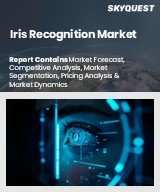
Report ID: SQMIG45A2587
Skyquest Technology's expert advisors have carried out comprehensive research on the iris recognition market to identify the major global and regional market trends and growth opportunities for leading players and new entrants in this market. The analysis is based on in-depth primary and secondary research to understand the major market drivers and restraints shaping the future development and growth of the industry.
Enhanced Security and Privacy Requirements
Widespread Adoption of Contactless Technologies
Technical and Integration Challenges
Presence of Competing Biometric Technologies
REQUEST FOR SAMPLE
Global Iris Recognition market size was valued at USD 3.7 Billion in 2023 and is poised to grow from USD 4.4 Billion in 2024 to USD 13.6 Billion by 2032, growing at a CAGR of 17.5% in the forecast period (2025-2032).
To remain competitive in the Iris Recognition market, leading companies are prioritizing innovation, digital security, and user-centric solutions. Firms are actively investing in AI-enhanced biometric algorithms, cloud-based identity platforms, and energy-efficient recognition systems to improve accuracy, speed, and scalability across diverse applications. Enhanced automation, contactless authentication, and integration with existing IT infrastructure are becoming essential features for market leaders aiming to deliver seamless and secure user experiences. 'Thales Group', 'IDEMIA ', 'HID Global Corporation', 'Iris ID, Inc.', 'IriTech, Inc.', 'IrisGuard Ltd.', 'NEC Corporation', 'Princeton Identity', 'CMITech Company, Ltd.', 'TECH5', 'BioEnable', 'FotoNation', 'Aware Inc.', 'Voxx International Corporation (EyeLock LLC)', 'Hangzhou Hikvision Digital Technology Co., Ltd.'
In an era of escalating cybersecurity threats and data breaches, iris recognition offers a highly secure and tamper-resistant method of identity verification. Enterprises and institutions in sectors such as banking, healthcare, and defense are adopting iris-based authentication systems to safeguard sensitive data, ensure regulatory compliance, and reduce fraud. The non-invasive nature of iris recognition—paired with its near-zero false match rate—is making it an increasingly attractive alternative to traditional access control systems.
Short-Term: In the near future, automation and artificial intelligence (AI) are accelerating transformation in the Iris Recognition market, enhancing document processing accuracy, scalability, and workflow efficiency. AI-powered features—such as intelligent document classification, predictive routing, and real-time output optimization—are enabling organizations to automate manual print and communication processes, reduce operational costs, and increase productivity. Cloud-based OMS platforms with built-in analytics are helping businesses meet growing demands for speed, personalization, and regulatory compliance while supporting sustainability goals by reducing reliance on paper-based output.
Why is North America Leading the Iris Recognition Market in 2024?
Want to customize this report? This report can be personalized according to your needs. Our analysts and industry experts will work directly with you to understand your requirements and provide you with customized data in a short amount of time. We offer $1000 worth of FREE customization at the time of purchase.
Feedback From Our Clients

Report ID: SQMIG45A2587
sales@skyquestt.com
USA +1 351-333-4748